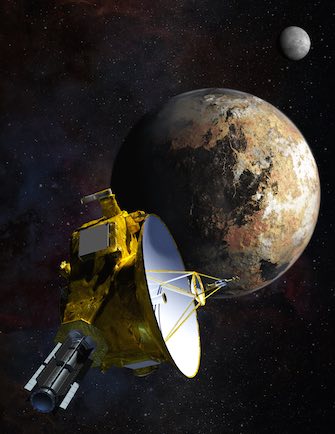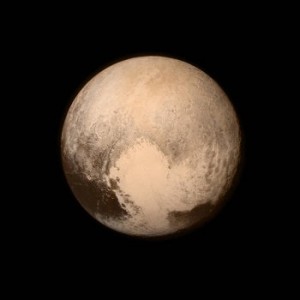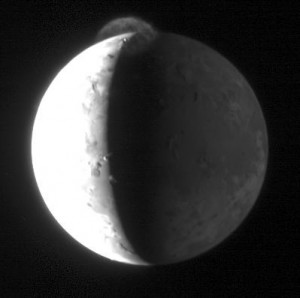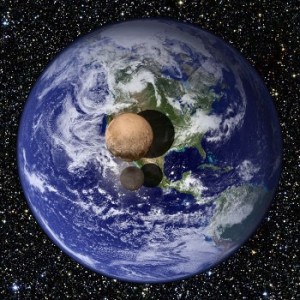The celestial body known to the world as Pluto is situated so far out on the fringes of our solar system that it is nearly impossible to convey the incredible distance, 4.67 billion miles away from our own planet. That’s nearly three times the distance from Earth to Uranus (1.6 billion at their closest orbits) and almost twice the distance from Earth to Neptune (2.7 billion miles), although the elliptical nature of Pluto’s orbit is such that it slips within Neptune’s orbit once every Pluto year, which is equivalent to 248 Earth years. The New Horizons NASA probe raced towards Pluto at speeds ranging from 30,000 mph up to nearly 50,000 mph and it still took almost a decade for the craft to arrive.
Arrive it did, however, and on Tuesday, July 14th, NASA and the wider astronomy world rejoiced when New Horizons sent word back to Earth that it had reached Pluto and was able to carry out its scientific research mission at that planet. The feat means that the United States has now become the only country in the world to have visited each planet of the classical solar system.
The data and images collected by the New Horizons probe will take years to properly analyze for scientists to glean all of the important details of this member of our solar system. However, it was clear right away that scientists had gotten some assumptions about the planet wrong. Pluto ended up having a diameter of 1,473 miles, making it smaller than our Moon but larger than previously predicted. This diameter makes Pluto about one-fifth the size of Earth.
New Horizons got started on its way to Pluto on January 19th, 2006, when it launched from Cape Canaveral in the payload dock of an Atlas V launch vehicle. The probe reached speeds of 36,000 mph during the launch, making it the fastest spacecraft launch ever recorded. The vehicle moved so fast that it reached Jupiter on February 27th, 2007, not long after the mission’s first anniversary. The same trek took more than a year and a half for Pioneer 10, the first spacecraft to visit Jupiter, to make more than four decades ago.
The New Horizons flyby of Jupiter was carefully designed so that the craft would receive an energy boost through a gravity assist maneuver. This method required New Horizons to fly within the gravitational well surrounding Jupiter so that the craft could be whipped out into space like a slingshot, collecting an additional 9,000 mph of speed for its journey. The maneuver actually transferred some of Jupiter’s energy to the craft, although Jupiter so massive and the gravitational force lost so small that the loss of energy would be imperceptible to someone on Jupiter. Without this assist, New Horizons would have taken an additional five years to reach Pluto.
The scientific instruments installed upon New Horizons were dormant for the vast majority of the trip so as to make sure that they were all in good working condition when the craft reached its target. However, those instruments were woken up during the Jupiter flyby and were able to capture some incredible sights. For instance, a time lapse of images taken by New Horizon’s camera recorded a volcanic explosion happening on the Jupiter moon of Io, marking the first volcanic explosion observed outside of Earth.
The payload of scientific instruments carried aboard the New Horizons craft is a treasure trove of state-of-the-art data collection tools which can help unlock many of Pluto’s secrets over time. The images of Pluto that have been getting worldwide attention come from the Long Range Reconnaissance Imager (LORRI), the largest camera on New Horizons and an instrument developed at the John Hopkins University Applied Physics Laboratory (APL). LORRI’s telephoto lens is so precise that it can take a clear and detailed satellite image of Manhattan while flying 7,000 miles above the Earth, something that most satellites can only accomplish at 400 miles. Interestingly, these are our first high resolution pictures of Pluto as the Hubble Space Telescope cannot take clear photos of the planet because of its small size and extreme distance from the Earth (Hubble takes images of galaxies millions of light years away, but those objects are on a much larger order of magnitude than Pluto).
The space around Pluto will be explored by a couple of instruments, Solar Wind Around Pluto (SWAP) and the Venetia Burney Student Dust Counter (SDC), named after the young girl who named the planet back in 1930. SWAP, developed at the Southwest Research Institute, will measure the solar winds interacting with Pluto to determine how much material is escaping the planet’s atmosphere due to weak gravitational forces. Because of Pluto’s distance from the sun, SWAP had to be designed with the world’s largest aperture instrument ever. The SDC, created by students at the University of Colorado at Boulder, will analyze the space dust found within the Pluto system in an attempt to determine the collision rate of objects near Pluto and in the wider Kuiper belt. The Kuiper belt is a region of space beyond Neptune’s orbit containing hundreds of icy dwarf planets much like Pluto; the fact that there are so many other planetary objects in Pluto’s region, and not the planet’s size, is the main reason why debate over Pluto’s status as a planet has loomed over the New Horizons mission.
A group of spectrometry instruments on New Horizons will open up a great deal of information on the chemical makeup of the planet and the entire region of space around it. Two more instruments from the Southwest Research Institute and named after characters from the TV classic The Honeymooners will give NASA the data it needs to determine the chemical composition of Pluto’s surface and atmosphere. Alice utilizes a compact telescope, an electronic detector and a spectrograph, which together are powerful enough to detect traces of atmospheric gases. Alice will look for an ionosphere on Pluto as well as on Charon, the largest of Pluto’s five moons. Ralph, Alice’s counterpart, has a series of black-and-white and color imagers as well as an infrared array detector to map Pluto and any surrounding Kuiper Belt Objects. An additional infrared compositional mapping spectrometer, the Linear Etalon Imaging Spectral Array (LEISA), will map the chemical makeup of Pluto and its moons. As if all that weren’t somehow enough, the Pluto Energetic Particle Spectrometer Science Investigation (PEPSSI), another APL creation, will try to identify neutral atoms leaving Pluto’s atmosphere and interacting with the solar winds. This is the most compact and lowest power directional energetic particle spectrometer flown on a space mission and is much more effective than SWAP at determining the energy of particles.
These scientific data collection instruments are rounded out by the Radio Science Experiment, also known as REX. This signal-processing device, consisting of a small printed circuit board receives a radio signal uplink sent from Earth, which helps REX to identify aspects of the molecular weight of the gases in Pluto’s atmosphere. Radio wave measuring techniques have already helped to give NASA researchers a more precise and accurate knowledge of Pluto’s size.
With all of this scientific firepower found aboard New Horizons, a hiccup in the craft’s on-board processing unit just 10 days before its encounter with Pluto caused no small amount of consternation. An overload in data communications caused NASA mission specialists to lose contact with the craft’s instruments for a brief period of time. Thankfully a backup processor was able to restore operability to New Horizons before it brushed past Pluto.
Aside from the updated knowledge of Pluto’s actual size, the New Horizon’s mission has already led to some stunning discoveries about this far-flung member of our solar system. After the Pluto flyby, NASA revealed that the physical layout of the ice on Pluto, thicker at the equator than it is at Pluto’s poles, was different than expected. The agency did confirm the presence of methane, which has now been found on every major celestial object studied by NASA. Expectations that Pluto would be an old battered ball of rock and ice were upturned by images indicating that not only is Pluto relatively unscathed by impacts, the planet is geologically active and considered to be one of the youngest surfaces in the solar system by NASA New Horizons team members.
New Horizons was out of contact with Earth for a period of 22 hours as it was busy devoting all of its processing power to collecting rich stores of astronomical data for Pluto. After having zipped past that planet, the mission will choose other Kuiper Belt Objects as targets for further scientific exploration. Ancient bodies of rock and ice such as Quaoar or Eris, a planetary body larger than Pluto which was first discovered in 2005, could hold more clues to the history of our solar system’s creation.

![[IPWatchdog Logo]](https://ipwatchdog.com/wp-content/themes/IPWatchdog%20-%202023/assets/images/temp/logo-small@2x.png)





![[Advertisement]](https://ipwatchdog.com/wp-content/uploads/2024/04/Artificial-Intelligence-2024-REPLAY-sidebar-700x500-corrected.jpg)
![[Advertisement]](https://ipwatchdog.com/wp-content/uploads/2024/04/UnitedLex-May-2-2024-sidebar-700x500-1.jpg)
![[Advertisement]](https://ipwatchdog.com/wp-content/uploads/2024/04/Patent-Litigation-Masters-2024-sidebar-700x500-1.jpg)

![[Advertisement]](https://ipwatchdog.com/wp-content/uploads/2021/12/WEBINAR-336-x-280-px.png)
![[Advertisement]](https://ipwatchdog.com/wp-content/uploads/2021/12/2021-Patent-Practice-on-Demand-recorded-Feb-2021-336-x-280.jpg)
![[Advertisement]](https://ipwatchdog.com/wp-content/uploads/2021/12/Ad-4-The-Invent-Patent-System™.png)






Join the Discussion
7 comments so far.
Steve Brachmann
August 24, 2015 11:15 pm@Aljo – As per the link provided, the maximum distance between Pluto and Earth is 4.67 billion miles. When their orbits bring them to their closest minimum distance, then the distance between the two planetary bodies is only 2.66 billion miles. Thank you for pointing out the discrepancy.
Jay
August 17, 2015 06:34 pmNice article. It will be grt if you specify something about the pluto’s Moons
Chris Cribbs
August 17, 2015 05:37 amLorri can photograph Manhattan 7000 miles above the Earth. I wonder at which period on the vessel’s journey upward and…away?ward from the planet they were able to confirm this fact. If the average velocity near launch was 36,000 miles/hr it is necessary to also know the instantaneous velocity by calculating acceleration using simple Newtonian differential calculus of the New Horizons vessel when it was roughly 7000 miles away from the planet. Getting good focus for my smartphone is difficult when I am standing still, then again I am not as quick as a computer. The computational power of the New Horizons LORRI must be astronomically hard working overtime to snap Manhattan with no red eye. Respect NASA.
Nikhil Rodrigues
August 17, 2015 12:34 amHi Steve, you have given a very descriptive and wonderful article on Pluto. I had a query if you could answer – is it possible with the latest technology available to obtain direct, coloured images/videos of planets/dwarf-planets/other bodies from a spacecraft? In case of New Horizons we have the LORRI which captures black-and-white images and the RALPH to study the colour graphics; and with these two aspects combined we get the closely approximate true colour-ed representation of the object under study.
Aljo
August 16, 2015 05:19 pmPluto is only 3 billion miles away. Confused with kilometres?
Vendicar Decarian
August 16, 2015 10:15 amYou are about 3 weeks late with this story Steve.
Rico
August 16, 2015 09:50 amEris is more massive than Pluto, but New Horizons confirmed that Pluto was in fact larger.